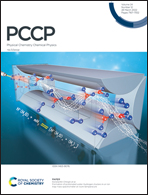Proton transfer-induced competing product channels of microsolvated Y−(H2O)n + CH3I (Y = F, Cl, Br, I) reactions†
Abstract
The potential energy profiles of three proton transfer-involved product channels for the reactions of Y−(H2O)1,2 + CH3I (Y = F, Cl, Br, I) were characterized using the B97-1/ECP/d method. These three channels include the (1) PTCH3 product channel that transfers a proton from methyl to nucleophile, (2) HO−-induced nucleophilic substitution (HO−-SN2) product channel, and (3) oxide ion substitution (OIS) product channel that gives CH3O− and HY products. The reaction enthalpies and barrier heights follow the order OIS > PTCH3 > HO−-SN2 > Y−-SN2, and thus HO−-SN2 can compete with the most favored Y−-SN2 product channel under singly-/doubly-hydrated conditions, while the PTCH3 channel only occurs under high collision energy and the OIS channel is the least probable. All product channels share the same pre-reaction complex, Y−(H2O)n–CH3I, in the entrance of the potential energy profile, signifying the importance of the pre-reaction complex. For HO−/Y−-SN2 channels, we considered front-side attack, back-side attack, and halogen-bonded complex mechanisms. Incremental hydration increases the barriers of both HO−/Y−-SN2 channels as well as their barrier difference, implying that the HO−-SN2 channel becomes less important when further hydrated. Varying the nucleophile Y− from F− to I− also increases the barrier heights and barrier difference, which correlates with the proton affinity of the nucleophiles. Energy decomposition analyses show that both the orbital interaction energy and structural deformation energy of the transition states determine the SN2 barrier change trend with incremental hydration and varying Y−. In brief, this work computes the comprehensive potential energy surfaces of the HO−-SN2 and PTCH3 channels and shows how proton transfer affects the microsolvated Y−(H2O)1,2 + CH3I reaction by competing with the traditional Y−-SN2 channel.



 Please wait while we load your content...
Please wait while we load your content...